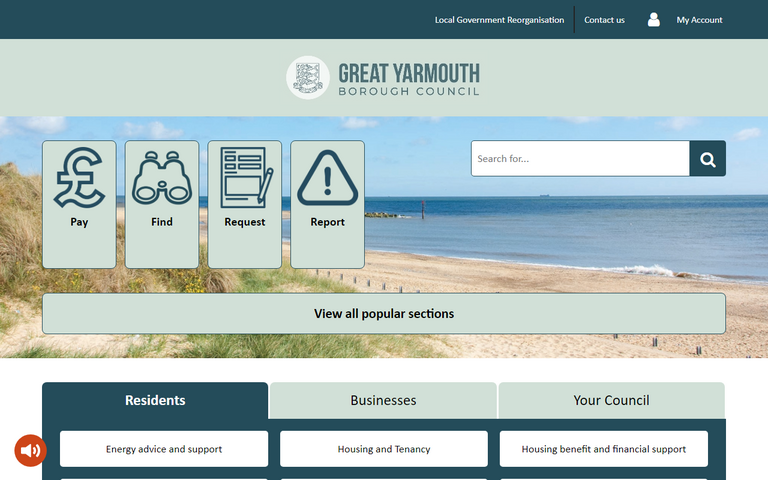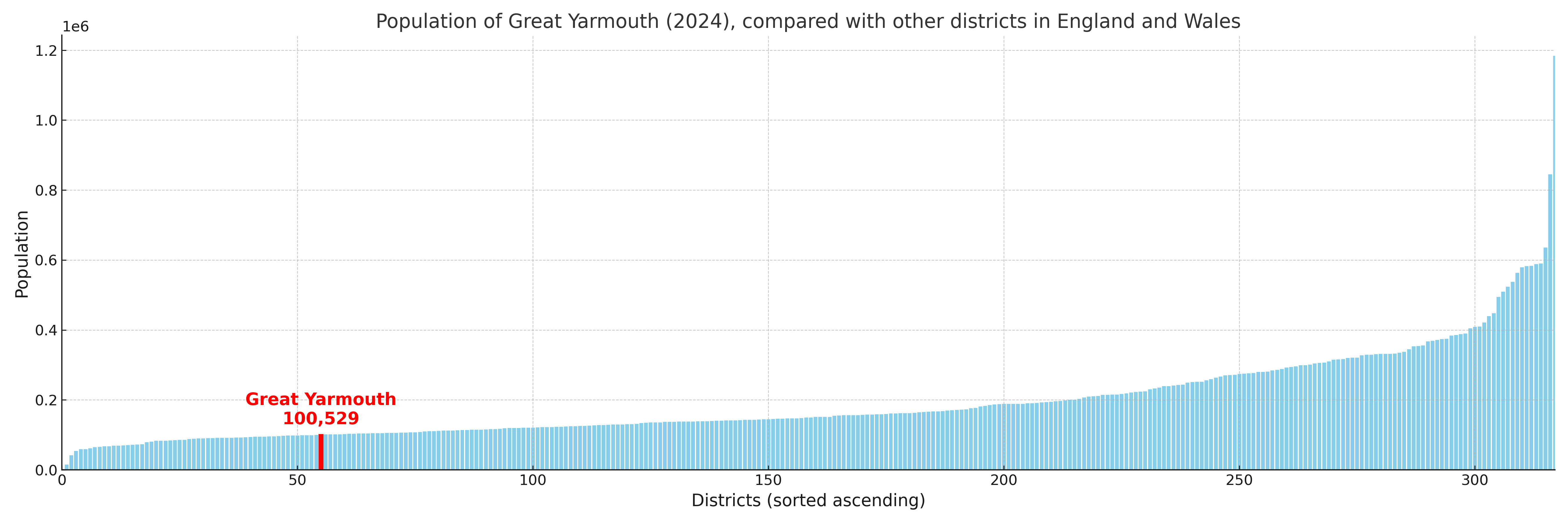Great Yarmouth
§ This page gives an overview of the Great Yarmouth local authority district, bringing together key facts, maps, and data to help you quickly understand the area. One of 361 district profiles on Baseview.
Overview ⁞ Great Yarmouth is a coastal district in Norfolk, famous for its sandy beaches, seaside attractions, and maritime heritage. The town of Great Yarmouth features a historic seafront with piers, amusements, and the Time and Tide Museum celebrating fishing and industry. The River Yare runs through, connecting with the Broads, and Breydon Water forms a vast tidal expanse for birdlife. Inland villages and the Broads National Park add diversity, while coastal dunes and beaches attract visitors. Its blend of seaside resort, history, and natural beauty defines the district.
Great Yarmouth Boundary Map
This map shows the official boundary of the Great Yarmouth local authority district, based on the latest geographic data published by the Office for National Statistics (ONS). It provides a clear view of the district’s extent and helps you understand how the area fits within the wider regional and national landscape.
Contains OS data © Crown copyright and database right 2025. Source: Office for National Statistics licensed under the Open Government Licence v3.0.
The administrative boundary of Great Yarmouth can also be viewed on OpenStreetMap: District Boundary of Great Yarmouth.
Key Facts about Great Yarmouth
What region is Great Yarmouth in? Great Yarmouth is in the East of England of England, a region within the UK.
What county is Great Yarmouth in? Great Yarmouth is located in the county of Norfolk.
Is Great Yarmouth a city? No, Great Yarmouth is not a city. (Note: the UK has 76 officially designated cities.)
Who governs Great Yarmouth? The local authority for this district is: Great Yarmouth Borough Council - responsible for district-level services. Since Norfolk is a two-tier area, county-level services are handled by: Norfolk County Council.
▶ Official website of Great Yarmouth Borough Council 🔗 great-yarmouth.gov.uk

Which police force covers Great Yarmouth? Policing in Great Yarmouth is provided by Norfolk Constabulary 🔗 norfolk.police.uk, which serves 7 local authority districts: Breckland ⁞ Broadland ⁞ Great Yarmouth ⁞ King's Lynn and West Norfolk ⁞ North Norfolk ⁞ Norwich ⁞ South Norfolk.
Constituencies in Great Yarmouth
Great Yarmouth is divided into 1 parliamentary constituencies, listed below in alphabetical order.
A constituency is a specific geographical area that elects one Member of Parliament (MP) to represent them in the House of Commons. The United Kingdom is divided into 650 parliamentary constituencies. We have this list page for easy browsing of all UK parliamentary constituencies: List of Constituencies.
Wards in Great Yarmouth
Great Yarmouth is divided into 17 wards, listed below in alphabetical order.
- Bradwell North
- Bradwell South and Hopton
- Caister North
- Caister South
- Central and Northgate
- Claydon
- East Flegg
- Fleggburgh
- Gorleston
- Lothingland
- Magdalen
- Nelson
- Ormesby
- Southtown and Cobholm
- St Andrews
- West Flegg
- Yarmouth North
In the UK, a ward is a subdivision of a local authority area, used mainly for electoral and statistical purposes. Defined by the ONS, wards represent the primary unit for local elections, each returning one or more councillors to the local council. Wards are also used as a key geography for presenting population and census data.
Parishes in Great Yarmouth
Great Yarmouth is part-parished: 21 civil parishes (listed A-Z below) alongside 2 unparished areas.
- Ashby with Oby
- Belton with Browston
- Bradwell
- Burgh Castle
- Caister-on-Sea
- Filby
- Fleggburgh
- Fritton and St. Olaves
- Hemsby
- Hopton-on-Sea
- Martham
- Mautby
- Ormesby St. Margaret with Scratby
- Ormesby St. Michael
- Repps with Bastwick
- Rollesby
- Somerton
- Stokesby with Herringby
- Thurne
- West Caister
- Winterton-on-Sea
A civil parish is the lowest tier of local government in England, used for villages, small towns, and suburbs. They have their own local authority, either a parish council or a parish meeting, which provides local services like managing parks, allotments, and streetlights, and represents the community's views to larger councils.
Built-up Areas in Great Yarmouth
Great Yarmouth covers 14 built-up areas, listed below in alphabetical order.
- Belton (Great Yarmouth)
- Bradwell (Great Yarmouth)
- Burgh Castle
- Burgh St Margaret
- Caister-on-Sea
- Filby
- Gorleston-on-Sea
- Great Yarmouth
- Hemsby
- Hopton on Sea *
- Martham
- Ormesby St Margaret
- Rollesby
- St Olaves *
In the UK, a Built-up Area (BUA) is a continuous urban area of at least 20 hectares (0.2 km²), defined by the ONS as land where buildings are generally no more than 200 metres apart, such as towns, cities, or large villages. (Note: A BUA name marked with an asterisk (*) indicates that the area is situated partly in the district of Great Yarmouth.)
Great Yarmouth compared with other districts in the UK
This section shows how Great Yarmouth compares with other local authority districts in the UK, using a variety of measures and rankings.
Great Yarmouth has 17 electoral wards.

Great Yarmouth has a population of 100,529 (2024 mid-year estimate by ONS)

More local statistics and data for Great Yarmouth can be found on the ONS statistics for Great Yarmouth.